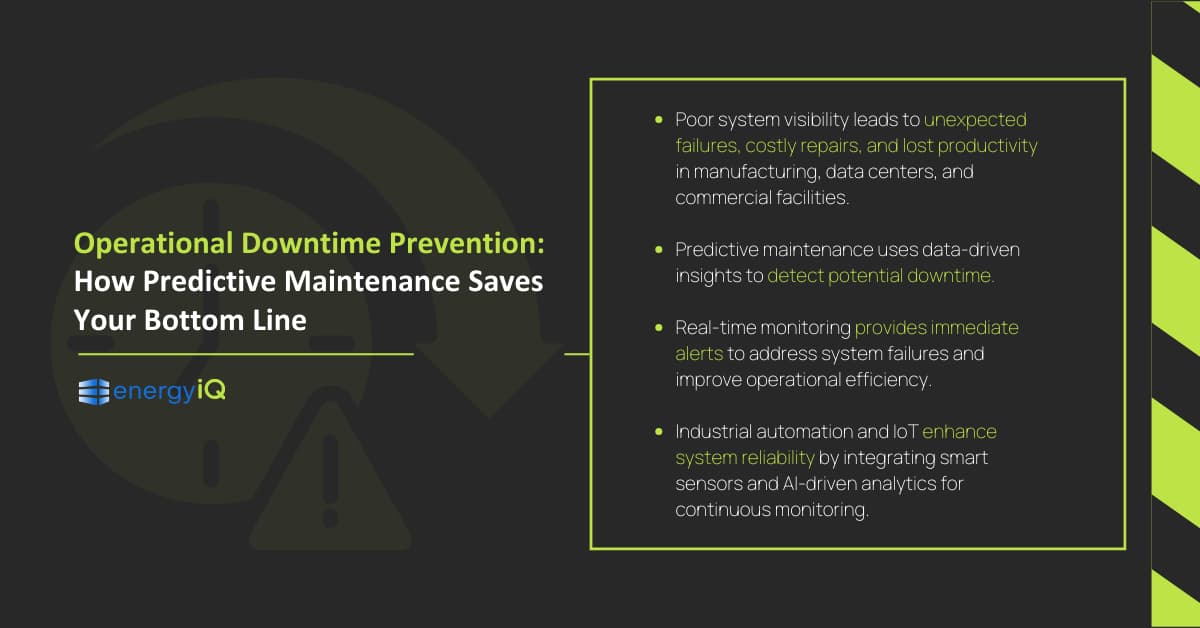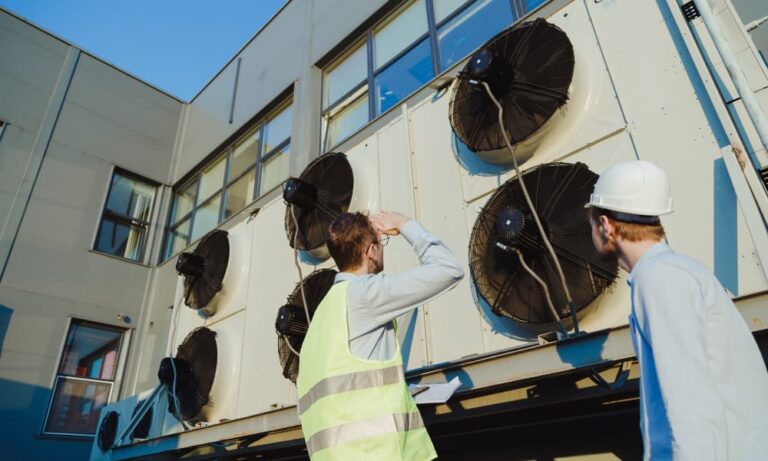Operational downtime prevention is essential for protecting profits and ensuring seamless operations. Let’s explore how real-time monitoring, automation, and predictive maintenance can eliminate costly disruptions and keep your systems running efficiently.

Downtime is a direct threat to profitability in a world where efficiency and reliability are key to staying competitive.
Even a short disruption can lead to massive financial losses in industries that rely on continuous operations An ITIC study found that 98% of organizations say a single hour of downtime costs them over $100,000, with some losing millions per incident.
So, what’s causing these unexpected failures?
A major culprit is poor system visibility, or the lack of real-time insight into critical systems’ performance. You react to failures instead of preventing them when small issues are not detected before they become big problems. Industries like manufacturing, data centers, and commercial facilities are especially vulnerable to downtime-related losses. Smarter strategies are needed to avoid these costly disruptions beyond simply reacting to the failures.
Here’s how smart solutions can help reduce costs, improve system reliability, and keep your operations running without costly interruptions.
The financial impact of downtime
The true cost of downtime goes beyond fixing broken equipment. Here’s a breakdown of the direct (and indirect) costs of downtime across three major industries:
– Manufacturing
The average manufacturer faces a staggering 800 hours of equipment downtime each year. Further studies reveal that unplanned downtime costs manufacturers an average of $260,000 per hour.
Apple’s supplier’s factory fire in India caused significant disruption to its supply chain, for example. The exact revenue loss is undisclosed, but interruptions in Apple’s supply chain have historically cost the company millions in lost sales, equipment repairs, and work hours.
– Data centers
The direct costs of downtime in data centers can be astronomical. Every minute of lost service can mean thousands, if not millions, in lost revenue, depending on the size of the operation. The indirect costs can be even more damaging, as a service outage can lead to frustrated users and canceled accounts.
One of the most high-profile outages occurred in October 2021, when a configuration error at Facebook’s data centers caused a six-hour outage. Facebook lost an estimated $100 million in ad revenue during the downtime.
– Commercial facilities
Direct downtime costs commercial buildings in emergency repairs and operational disruptions. An HVAC system that fails during peak summer months can force businesses to close temporarily, for example, leading to immediate revenue loss. Electrical failures or security system malfunctions can also require expensive, urgent fixes that aren’t within the budget.
The indirect impact is just as concerning. Downtime can throw off supply chains in manufacturing, causing missed deadlines and late deliveries. Repeated disruptions in data centers can damage a company’s reputation, making it harder to secure contracts and retain loyal customers.
Why poor system visibility leads to downtime
Traditional maintenance methods rely on fixing equipment after failure rather than preventing breakdowns. Without real-time system data, diagnosing issues becomes guesswork.
Technicians must manually inspect equipment, test components, and rely on historical data to pinpoint failures. This delays repairs and increases overall downtime, leading to lost revenue and operational inefficiencies.
Here are a few examples of how a lack of real-time data slows troubleshooting.
– Hotels
A failing HVAC system in a hotel means discomfort and translates to lost bookings, negative reviews, and unhappy guests. Real-time monitoring stops issues like faulty air conditioning or heating failures that would otherwise go unnoticed until they disrupt operations.
-Data centers
Data centers depend on uninterrupted power and precise cooling to keep servers running efficiently. Poor system visibility can lead to overheating, power fluctuations, and full-scale outages, threatening uptime guarantees and resulting in millions in lost revenue for cloud service providers.
– Engineering firms
Modern high-performance buildings rely on smart energy management and automated controls. Issues like ventilation failures, inefficient lighting, and unbalanced loads can cause significant inefficiencies when visibility is lacking. And engineers struggle to maintain system resilience, leading to higher energy costs and unexpected equipment failures.
Predictive maintenance and real-time monitoring are key to avoiding these costly disruptions. Better system visibility means businesses can anticipate failures, reduce downtime, and improve efficiency.
The role of predictive maintenance and real-time monitoring
Predictive maintenance is a proactive approach that uses data, sensors, and AI-driven analytics to detect early signs of equipment failure before breakdowns. Real-time monitoring solutions take predictive maintenance a step further by providing immediate alerts when potential system failures are detected.
The benefits of preventive maintenance and real-time monitoring are undeniable:
- Proactive measures allow businesses to address issues before they escalate.
- This results in reduced repair costs and extended equipment lifespan.
- Data-driven insights from continuous monitoring help optimize energy usage, improve overall efficiency, and lower operational expenses.
A great example is the Marriott Marquis case study, where EnergyIQ implemented real-time monitoring and automation to enhance system reliability. Ensuring continuous oversight of all systems and subsystems enabled the hotel to detect potential failures before they caused disruptions. This smart approach allowed the Marriott Marquis to maintain seamless operations, enhance guest comfort, and maximize long-term savings—all while reducing downtime risks.
How automation and industrial IoT improve system reliability
Industrial settings are moving away from the old-school, reactive approach to maintenance. Businesses are instead shifting to proactive maintenance, using technology to anticipate issues before they cause downtime.
Industrial automation takes this further by using IoT sensors for continuous monitoring and AI-driven analytics to predict failures. These smart systems analyze real-time data, detecting unusual patterns that might indicate an upcoming issue. Immediate alerts and data-driven insights mean you can fine-tune performance, optimize energy use, and prevent breakdowns before they happen.
Even mechanical contractors are adapting to building automation, gaining a competitive edge by offering real-time monitoring solutions that help their clients cut costs, minimize downtime, and maximize system efficiency.
Industry-specific solutions for downtime prevention
Different industries face unique downtime challenges, but smart automation and real-time monitoring offer tailored solutions to keep operations running smoothly. Let’s take a look at industry-specific solutions for downtime prevention:
– Hotels
Guest experience is everything in the hospitality industry, and a failing HVAC system can lead to discomfort, complaints, and lost revenue. Automation helps hotels maintain optimal temperature and air quality by continuously monitoring HVAC performance. Automated systems can detect issues early and adjust quickly to prevent unexpected failures.
– Data centers
Data centers rely on uninterrupted power and precise cooling to keep servers running efficiently. Smart monitoring systems track energy usage, detect temperature fluctuations, and identify potential failures before they cause costly downtime.
– Manufacturing
Even a minor disruption in manufacturing can throw off production schedules and impact supply chains. Real-time data allows manufacturers to monitor equipment performance, detect inefficiencies, and address issues before they escalate.
– Commercial facilities
Commercial facilities rely on multiple systems–HVAC, lighting, security, and electrical–to keep operations running smoothly. Integrated building management systems (BMS) provide centralized control and real-time monitoring, which allow facility managers to detect inefficiencies, prevent failures, and optimize energy use.
Boost reliability and cut costs with EnergyIQ’s automation and smart monitoring
Poor system visibility exposes businesses to unexpected failures, soaring repair costs, and lost productivity. What starts as a minor issue can quickly escalate into a costly disruption with no real-time insight into system performance.
Predictive maintenance and real-time monitoring transform the equation by detecting potential failures before they occur. These proactive solutions reduce repair expenses, extend equipment lifespans, and improve energy efficiency, keeping operations running smoothly.
Don’t wait for the subsequent costly breakdown. Contact EnergyIQ today to learn how we can help you prevent downtime and improve operational efficiency.



